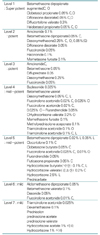The Pharmacologic Treatment of Atopic Dermatitis
Article information
Abstract
Atopic dermatitis (AD) is a chronic inflammatory pruritic skin disease that affects a large number of children and adults in Korea. The treatment of AD requires a comprehensive approach that includes evaluation of potential triggers and education of the patients and family members regarding proper avoidance measures. Because existing remedies for AD do not cure the disorder itself, a program of disease control and management should be pursued. Topical corticosteroids are the effective and relatively safe therapy for patients with AD, but prolonged usage can result in skin atrophy and other side-effects. The topical calcineurin inhibitors such as pimecrolimus and tacrolimus allow a steroid-free, anti-inflammatory topical therapy of AD. Occasionally, however, children afflicted with severe AD require more intensive therapies (e.g., ultraviolet light exposure systemic corticosteroids, and cyclosporine) that need close monitoring. This review focuses on the current guidelines of managing AD regarding the efficacy and safety of several pharmacologic options. Management strategies discussed include topical corticosteroids, topical calcineurin inhibitors, antihistamines and anti-infectives. A management algorithm is also presented.


